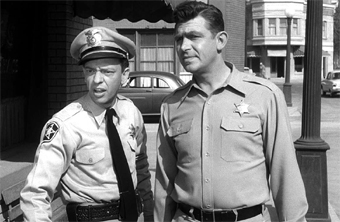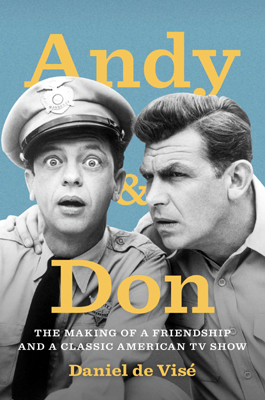
Image courtesy CBS Television/Paramount
Andy & Don:
The Making of a Friendship and
a Classic TV Show; Daniel de Visé
| published February 22, 2016 |
Review by Kevin Robbie, Thursday Review contributor
Like millions of people, I grew up watching the Andy Griffith Show, arguably one of the greatest classic comedies in television history. Some of my earliest memories of television involve the comedy of the show and the denizens of Mayberry, North Carolina. Over the years, I have also watched it innumerable times since the show has been in syndication. When my father bought our first color TV, the first thing my brother and I watched that afternoon was Andy Griffith. Reruns of the show remain one of the most popular staples of TV even to this day, decades after the show ended.
Strictly speaking, the Andy Griffith Show was not a situation comedy, at least not in the traditional sense. The show’s humor was based largely on its characters, and as such, remained consistent throughout the show’s seven-year primetime run. “Situations” come and go, but the Andy Griffith characters remained consistent throughout the years largely because of the outstanding writing and direction, as well as a similar vision between directors, producer and star, Andy Griffith.
It can be said that the Griffith show was, ultimately, a show about the friendship between the two principal characters—Sheriff Andy Taylor and his Deputy, Barney Fife. The story of that onscreen/offscreen friendship was recently told by author Daniel de Vise in his 320-page biography-retrospective book Andy and Don: The Making of a Friendship and a Classic American TV Show. De Vise points out that Griffith and Knotts were friends close off-screen, and their chemistry on film was reflective of their real-life friendship.
The author tells the story in the form of a chronological narrative beginning with the two actors’ childhoods. He provides compelling detail regarding the actors’ lives as boys and how their backgrounds influenced their later careers. The book delves into the private lives of Griffith and Knotts based on first-hand accounts from people who knew them, including friends, family members, agents, etc. Use of such sources lends credibility to the book as a whole. Through this window provided by the author, the reader is given a glimpse of the subjects’ interior worlds.

The result is that the reader is pulled into the story—the anecdotes De Vise’ offers show us many of the idiosyncrasies of Griffith and Knotts, and reveal the real-life side of each actors’ TV alter ego. Their off-screen lives seem to not measure up to the behavior and onscreen lives of Andy Taylor and Barney Fife. The disconnect between the two—the real life actors and the people they portray—made me realize and appreciate the deep talent possessed by both men, portraying characters so radically different from who they were in life outside of that TV screen.
The two actors had initially become friends while working on the Broadway play No Time for Sergeants. They also appeared in the movie version of the play. When the Griffith show pilot was aired as a single episode on The Danny Thomas Show, one person watching it was Don Knotts, who, at that moment, was unemployed. He and his wife were in New York playing cards at the home of actor Pat Harrington. Upon watching the show, Knotts immediately conceived the idea of a deputy for Andy Taylor, the sheriff of Mayberry, a fictitious town in rural North Carolina.
The next day, Knotts called Griffith and posed the deputy idea to him. Griffith was on board at that moment and, in turn, pitched the concept to Sheldon Leonard, the show’s producer and co-creator. Knotts appeared at Leonard’s office at Desilu Studios for an interview. He carried a sheaf of paper under his arm, random collection of old scripts meant to convey the impression that Knotts had numerous job offers awaiting his reply. Leonard played it cool and grilled Knotts with questions regarding how he would portray the character of the deputy. Knotts took the name of Fife for the deputy, naming him after a street in his hometown of Morgantown, West Virginia. After three weeks of consideration, Knotts was informed the part was his. Filming for The Andy Griffith Show began in the summer of 1960.
From very early in the show, Griffith and Knotts balanced friendship and professionalism to collaborate with the writers of the show, focusing on character development, stories and human interaction to create some of the funniest moments in television history. The actors would frequently discuss story ideas based on their childhoods, including people they knew and unusual or humorous situations in which they had found themselves. These ideas were conveyed to the writers and were often incorporated into the show.
Griffith and Knotts were paired on the show for five seasons, before Knotts left in order to pursue opportunities in Hollywood film. He appeared as Barney Fife in five additional episodes over the final three seasons of the show. The author details the personal motivations for Knotts leaving and recounts conversations between Knotts and Griffith regarding the former’s departure. Knotts appeared in later years on Matlock and the two men made other appearances together over the years. In 1986, they both starred in Return to Mayberry,” a wonderful and heart-warming stroke of nostalgia.
As friends, Andy and Don were quite different in their personalities. Griffith was an irascible curmudgeon prone to frequent short-tempered moments; he was also a bearer of grudges. Knotts was a somewhat manic hypochondriac, often unsure of himself and plagued by anxiety bordering on depression. Both men grew up in the South during the Great Depression and used comedy and acting to help them fit in socially when they were young. As adults, they admired and respected each other’s immense talent and drive. Their talent, professional relationship and offscreen friendship combined to produce onscreen magic and television history.
The show showcased many TV stars and beloved character actors, and produced many other stars from relative obscurity. Among the show’s regulars were Francis Bavier (as Aunt Bee, a staple of the Taylor household), Jim Nabors, George Lindsey, Howard McNear, Denver Pyle, and Jack Dodson, to name a few. Ron Howard and Clint Howard, as children, also made appearances; Ron, aka Ronnie Howard, played Andy’s son Opie for eight seasons. Among the show’s many legacies is Ron Howard’s large influence as a producer and director in Hollywood; the on-set learning he gained as a child in “Mayberry” was foundational to his later successful big screen achievements, such as Apollo 13, Backdraft, and Cinderella Man. Andy Griffith also spawned several well-known spin-offs, including Gomer Pyle, USMC, which starred Jim Nabors.
Andy and Don is as much a biography of a friendship as it is a narrative of a famous TV show. The author portrays the principals as human beings with flaws and personal quirks without dismissing them out of hand or dwelling on them. The book is balanced between showing the reader these mundane characteristics and showing Andy and Don as comedic geniuses. Andy and Don remained friends throughout the remainder of their lives. The legacy of their work together on the “Griffith” show is not only the obvious one of great television, but also one of enduring friendship.
Related Thursday Review articles:
M*A*S*H Star Wayne Rogers Dies as 82; R. Alan Clanton; Thursday Review; January 1, 2016.
Hope in an Actor’s Life; John Montana; Thursday Review; February 11, 2016.
